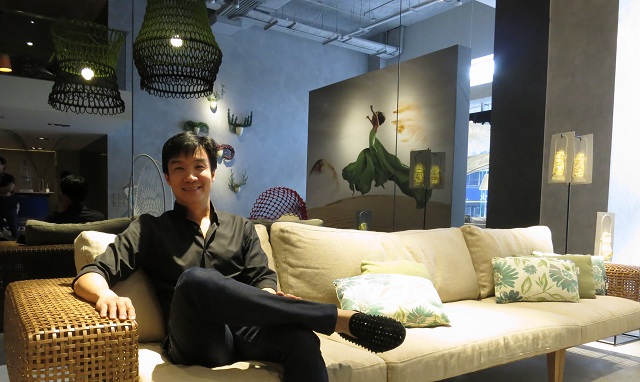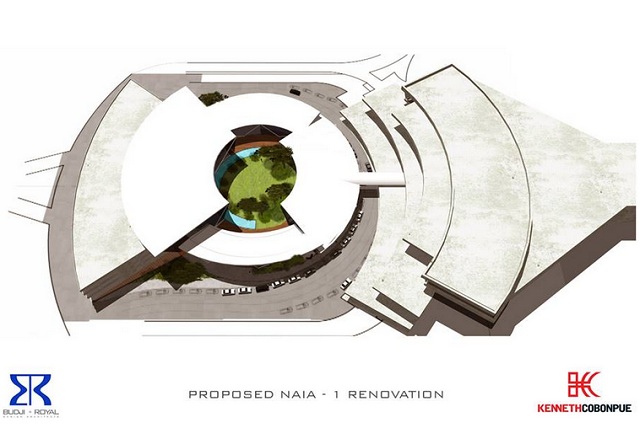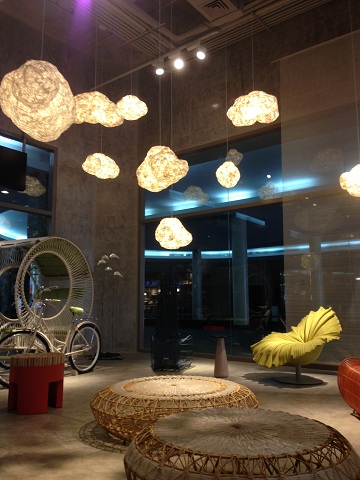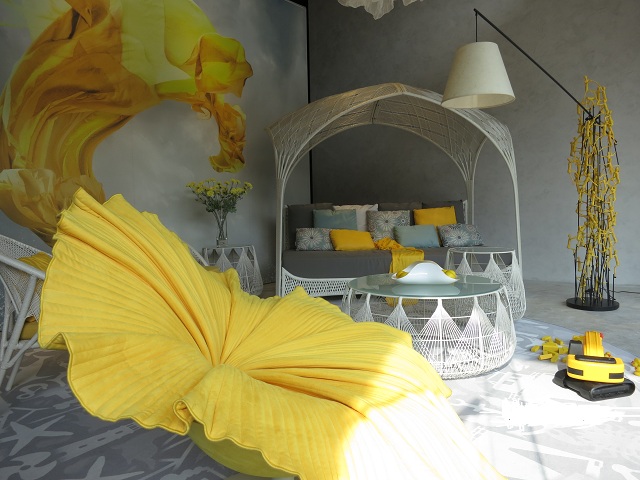Filtered By: Lifestyle
Lifestyle
Making it more fun in the Philippines: Q&A with Kenneth Cobonpue
Text and photos by MAX IGNACIO

In his element: Cobonpue in his Makati showroom.
Having his pieces featured in the movie "Ocean’s 13"—and gaining a friendship and a collaboration with Brad Pitt in the process—is only one of the many accomplishments that have assured Kenneth Cobonpue a place in the design hall of fame.
After opening his first store in the metro, the internationally renowned industrial designer is getting ready to tackle the next task on his to-do list: re-designing the interiors of the Ninoy Aquino International Airport Terminal 1. He and his team will do it for free—a very generous gesture, given the surely Herculean task of turning around an institution that has consistently made the top of lists of the world's worst airports.
Amazingly, Cobonpue and his team are doing the gratis redesign after being turned down the first time they offered to do it.
We met with the design superstar at the recent opening of his store at The Residences, Greenbelt, Makati City to pick the brains of a true maestro.
Q: Why did you accept the NAIA project despite being put off it the first time?
KENNETH COBONPUE: Our intentions never changed. We always wanted to help the country. We wanted to give back and we all thought we deserved a better airport. When we first accepted it, we were very hopeful and optimistic about the country. When they decided to give it back, we thought, the plans have been with them [the government] all along, so why not?

After opening his first store in the metro, the internationally renowned industrial designer is getting ready to tackle the next task on his to-do list: re-designing the interiors of the Ninoy Aquino International Airport Terminal 1. He and his team will do it for free—a very generous gesture, given the surely Herculean task of turning around an institution that has consistently made the top of lists of the world's worst airports.
Amazingly, Cobonpue and his team are doing the gratis redesign after being turned down the first time they offered to do it.
We met with the design superstar at the recent opening of his store at The Residences, Greenbelt, Makati City to pick the brains of a true maestro.
Q: Why did you accept the NAIA project despite being put off it the first time?
KENNETH COBONPUE: Our intentions never changed. We always wanted to help the country. We wanted to give back and we all thought we deserved a better airport. When we first accepted it, we were very hopeful and optimistic about the country. When they decided to give it back, we thought, the plans have been with them [the government] all along, so why not?

A re-imagining of NAIA by Cobonpue and his team. Image from Kenneth Cobonpue's Facebook account
Were there any qualms about doing it again?
The most unfortunate thing about what happened is all the lost time. We started before Solaire [Resort and Casino] broke ground; look at Solaire now.
How do you plan to turn around the reputation of NAIA?
The design is centered on a tropical garden. There’s a disconnect between our campaign, “It’s More Fun in the Philippines,” and arriving in the NAIA airport. The experience is not exactly fun. We want to show our country’s beauty the minute they set foot in our country.
What are your greatest worries in terms of giving NAIA a facelift?
Government execution. The façade will be one thing but another is the people manning it. A lot has to be changed in the airport. We had suggestions before to have a hotel operator manage the bathrooms and lounges so it goes to a private entity instead of the airport authorities.
At that time in fact, we had many volunteers coming from the industry. They were all willing to help. It was a bayanihan thing. We got letters from landscapers, engineers—all willing to offer up their services for free.
 How important is the “Made in the Philippines” tag for your creations?
How important is the “Made in the Philippines” tag for your creations?
It’s not a great marketing tool. Selling something on a higher price level and saying it’s made in the Philippines is suicide, but I think it’s really important that people know the truth, that we have some of the best craftsmen in the world.
Was your love of country triggered by something in the past?
I was born here. I love the people I work with. The craftsmen turn my dreams into reality every day. I lived abroad for almost six years and there’s nothing quite like them.
So many people would rather take their skills abroad. Why did you decide to stay on Philippine soil?
We have incredible resources. Plus, this is my edge, it’s my competitive advantage to stay in the country, run my own product development and oversee the creation of my products as opposed to competing with other designers abroad who are doing the same thing.
I want to take something personal, something that’s mine, and make it global. I like doing it my way.
What is the one thing you wish you knew when you were starting out in the business?
That it gets harder every year. There are so many new products out there, sometimes you fear that the creative well will run dry. Also, things are just getting more expensive to produce in the country. Labor’s going up, but it’s a natural thing. There are less people who want to do these things. More people want to go work in an office. There will come a time when it’s going to be harder to find people who would want to do things by hand.
 What was the last thing that inspired you?
What was the last thing that inspired you?
My dog giving birth a few weeks ago.
Why did you wait so long to open a store in Metro Manila?
I didn’t feel like I had enough products for a store. When you do a store, you have to sell everything—furniture, lighting. And you have to display it in vignettes.
I just feel I didn’t have enough variety yet to continually fill the space because you have to constantly fill up the space. But now, I felt it was time.
What piece are you working on next?
We’re designing an electric tricycle, the installation at Shangri-la Mall, plus another project with Shangri-la.
I have several around the world right now. A lot of hotel projects. I’ve been doing a lot of installations and interiors but it’s the electric tricycle I’m excited about.
If your pieces could speak a universal language, what would they say?
Fun. I think the pieces themselves have a childlike and whimsical aspect to them. I love when people sit down and they feel like it’s fun.
What are the top three characteristics of your designs that you won't compromise with?
Comfort, looks, and the environmental friendliness.

What is your advice to young aspiring Filipino designers?
I think you have to find something fresh and new. It doesn’t have to be 100 percent new, but you have to have something new about it. It’s okay to be similar, but you have to be better. You can be inspired by something but don’t copy it. You should improve it, if you can’t, don’t bother.
What legacy do you hope to leave behind?
I hope to inspire others to do the same thing I’m trying hard to do which is to push the envelope of design further and slowly create an identity for design locally. — BM, GMA News
The most unfortunate thing about what happened is all the lost time. We started before Solaire [Resort and Casino] broke ground; look at Solaire now.
How do you plan to turn around the reputation of NAIA?
The design is centered on a tropical garden. There’s a disconnect between our campaign, “It’s More Fun in the Philippines,” and arriving in the NAIA airport. The experience is not exactly fun. We want to show our country’s beauty the minute they set foot in our country.
What are your greatest worries in terms of giving NAIA a facelift?
Government execution. The façade will be one thing but another is the people manning it. A lot has to be changed in the airport. We had suggestions before to have a hotel operator manage the bathrooms and lounges so it goes to a private entity instead of the airport authorities.
At that time in fact, we had many volunteers coming from the industry. They were all willing to help. It was a bayanihan thing. We got letters from landscapers, engineers—all willing to offer up their services for free.

The Philippines has "some of the best craftsmen in the world," says the designer.
It’s not a great marketing tool. Selling something on a higher price level and saying it’s made in the Philippines is suicide, but I think it’s really important that people know the truth, that we have some of the best craftsmen in the world.
Was your love of country triggered by something in the past?
I was born here. I love the people I work with. The craftsmen turn my dreams into reality every day. I lived abroad for almost six years and there’s nothing quite like them.
So many people would rather take their skills abroad. Why did you decide to stay on Philippine soil?
We have incredible resources. Plus, this is my edge, it’s my competitive advantage to stay in the country, run my own product development and oversee the creation of my products as opposed to competing with other designers abroad who are doing the same thing.
I want to take something personal, something that’s mine, and make it global. I like doing it my way.
What is the one thing you wish you knew when you were starting out in the business?
That it gets harder every year. There are so many new products out there, sometimes you fear that the creative well will run dry. Also, things are just getting more expensive to produce in the country. Labor’s going up, but it’s a natural thing. There are less people who want to do these things. More people want to go work in an office. There will come a time when it’s going to be harder to find people who would want to do things by hand.

Whimsical but functional pieces on display in Cobonpue's new store.
My dog giving birth a few weeks ago.
Why did you wait so long to open a store in Metro Manila?
I didn’t feel like I had enough products for a store. When you do a store, you have to sell everything—furniture, lighting. And you have to display it in vignettes.
I just feel I didn’t have enough variety yet to continually fill the space because you have to constantly fill up the space. But now, I felt it was time.
What piece are you working on next?
We’re designing an electric tricycle, the installation at Shangri-la Mall, plus another project with Shangri-la.
I have several around the world right now. A lot of hotel projects. I’ve been doing a lot of installations and interiors but it’s the electric tricycle I’m excited about.
If your pieces could speak a universal language, what would they say?
Fun. I think the pieces themselves have a childlike and whimsical aspect to them. I love when people sit down and they feel like it’s fun.
What are the top three characteristics of your designs that you won't compromise with?
Comfort, looks, and the environmental friendliness.

The Bloom Club Chair (foreground) is a popular Cobonpue design.
What is your advice to young aspiring Filipino designers?
I think you have to find something fresh and new. It doesn’t have to be 100 percent new, but you have to have something new about it. It’s okay to be similar, but you have to be better. You can be inspired by something but don’t copy it. You should improve it, if you can’t, don’t bother.
What legacy do you hope to leave behind?
I hope to inspire others to do the same thing I’m trying hard to do which is to push the envelope of design further and slowly create an identity for design locally. — BM, GMA News
More Videos
Most Popular




